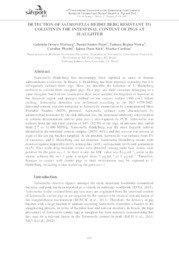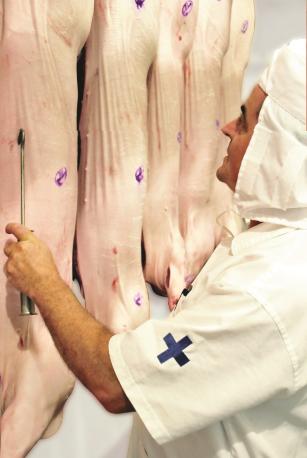Detection of salmonella heidelberg resistant to colistin in the intestinal content of pigs at slaughter.
Detection of salmonella heidelberg resistant to colistin in the intestinal content of pigs at slaughter.
Author(s): WERLANG, G. O.; PAIM, D. S; VIEIRA, T. R.; PISSETTI, C.; KICH, J. D.; CARDOSO, M. R. de I.
Summary: Abstract : Salmonella Heidelberg has increasingly been reported as cause of human salmonellosis worldwide. In Brazil, S. Heidelberg has been reported in poultry but it is infrequently isolated from pigs. Here, we describe the isolation of S. Heidelberg resistant to colistin from slaughter pigs. Five pigs and their carcasses belonging to a same slaughter batch in ten consecutive days were sampled for fragment of intestine in the ileocecal region and sponges rubbed on the carcass surface (400 cm2 ) before chilling. Salmonella detection was performed according to the ISO 6579:2002. Intestinal content was also subjected to Salmonella enumeration by a miniaturized Most Probable Number (MPN) protocol. Salmonella isolates were characterized by antimicrobial resistance by the disk diffusion test, the minimum inhibitory concentration to colistin determination and to gene mcr-1 investigation by PCR. Salmonella was isolated from the intestinal content of 64% (32/50) of the pigs, in amounts that varied from 2.7 to >1,400 MPN/g. Salmonella Heidelberg was the most frequent serovar identified in the intestinal content samples (20/50; 40%), and this serovar was present in eight of the ten pig batches sampled. At the prechill, Salmonella was isolated from 8% of carcasses, and S. Heidelberg was not detected. Salmonella Heidelberg strains were resistant against ampicillin (n=9), tetracycline (n=8), sulfonamide (n=8) and gentamicin (n=5). Nine multi-drug resistant strains were detected; among them four strains were positive for the gene mcr-1. In these strains the MIC value was 8 µg.mL-1 , while in the strains without the mcr-1 gene it ranged from 2 µg.mL-1 to 4 µg.mL-1 . Therefore, humans in contact with carrier pigs or their environment may be exposed to S. Heidelberg, including strains harboring the gene mcr-1.
Publication year: 2017
Types of publication: Paper in annals and proceedings
Unit: Embrapa Swine & Poultry
Keywords: Abate, Safe pork, Salmonella, Sanidade animal, Suíno
Observation
Some of Embrapa's publications are published as ePub files. To read them, use or download one of the following free software options to your computer or mobile device. Android: Google Play Books; IOS: iBooks; Windows and Linux: Calibre.
Access other publications
Access the Agricultural Research Database (BDPA) to consult Embrapa's full library collection and records.
Visit Embrapa Bookstore to purchase books and other publications sold by Embrapa.


